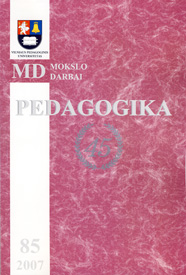Būsimojo muzikos mokytojo meninė individualybė: ugdymo galimybės ir ypatumai
The Artistic Individuality of the Future Music Teachers: Potentials and Peculiarities of Education
Author(s): Vilius TavorasSubject(s): Education
Published by: Vytauto Didžiojo Universitetas
Keywords: future music teacher; artistic image of the composition; artistic individuality.
Summary/Abstract: The artide analyzes the individuality in the percept of a musical composition which determines the professional competency of future music teachers while applying the principle of image modeling. The main objective of the research is to reveal the peculiarities of images experienced by the person being educated. The artide considers whether an image is an effective means to uphold the artistic individuality of the people being educated. The goals: 1) to reveal the concepts of artistic individuality and artistic image in music pedagogics; 2) to reveal preconditions for the development of artistic individuality of the future music teachers at a choir studio and conduct dasses. In the educational project students - future music teachers - were asked to prepare themselves to conduct a Lithuanian folk song „Oi tu, ąžuolėli" to a choir harmonized by Z. Venckus. The main point of the research was to let each individuality bring out, show the depth of artistic experience, emotional variety and its variation of the person being educated while the student models his individual artistic image of the piece being performed. Each student was recommended to imagine a particular emotional situation displayiang his feelings. This situation in particular shows the cognitive and cogitative components playing the crucial role. The students found out the ethno-cultural, folk meaning of the oak, made up the seąuence of varying "emotional chains" of the song, which helped them to empathize with the piece being performed and show their personai feelings and emotional attitude. The conduct techniąue at the time the piece was being performed was a background only giving top priority to rendering the emotional plot by means of visual effect (mime, pantomime) empathizing the message of the song. The results of the research showed that each student feels the šame music intonations differently. This feature of perception is of great value from the viewpoint of pedagogical cognition of music, where the individuality of perception is used in expanding the activity and self-sufficiency of the person being educated. While stimulating and educating emotional resonance, fixation of artistic experience and its verbalization, the educator acąuires great opportunities for individuality formation because each person being educated conceptualizes his individual artistic image of the šame piece which matches his emotionality, maturity of thinking and willpower. This means that each student in his own way renders the artistic image conceptualized, empathizing with intonations of the piece and experiencing them respectively.
Journal: Pedagogika
- Issue Year: 2007
- Issue No: 85
- Page Range: 98-103
- Page Count: 6
- Language: Lithuanian

